
Home |
Up |
Prev |
Next |
The photography of invertebrates is great fun as it reveals a world that is not really visible to the naked eye. It can also be educational, causing us to learn about these humble creatures that we take for granted. Hopefully the interest we get from seeing the detail in a spider or an aphid will cause us to do a little research on the web and find out even more about these varied and fascinating creatures.
Of course, to photograph the very small requires a macro lens. Users of compact digicams have no idea how lucky they are, in that many of them have really excellent macro ability built into their cheap little devices. This is a happy quirk of little cameras and we all should make the most of it. Sadly SLR users are not so fortunate and true macro primes are moderately expensive.
True macro capability means a 1:1 ratio, ie if you take a photo of your sensor at the closest focal distance it will fill the frame. Compact digicams aren't normally true macro lenses but they are close enough to get great shots. Some SLR lenses call themselves "macro" but are only 2:1 or similar. These are usually cheap lenses which have not been specifically designed for macro work.
A macro shot requires that the subject be close to the lens. At 35mm the lens will be almost touching the creature which will probably scare it away. 50 and 60mm are the usual minimum focal lengths for such lenses, with 90 and 100mm generally considered the ideal, as this allows the lens to be a more comfortable distance back. Beyond 100mm the lens needs to hyper-extend and the excessive magnification makes camera blur a real problem.
Macro photography can be dead easy if you are photographing a beetle in the sunshine, but more often it is tricky and technically demanding:
- Because the lens is so close, the normally moderate speed of some insects can suddenly become lightning! A good example is ants. This can make framing and focusing a real challenge.
- The Depth of Field is narrower than normal in the macro world, so you often need to restrict the aperture, on the other hand you need to may keep the shutter speed up to avoid motion blur, tricky.
- Invertebrates will often be in less than ideal light so you will need to use flash, however you probably can't use the camera's normal flash as the lens will cast a large shadow. If you can use the flash you will find it is too powerful for a near subject so you must throttle it back. Serious macro heads will need to buy a dedicated macro flash unit such as a ring flash.
- Due to the magnification level of this form of photography, the camera is hyper-sensitive to camera shake. This means that the old standby of keep shutter speed over 1/FL doesn't work, you need quite a bit more. This effectively means that you need good image stabilisation, high shutter speed or a tripod. There is only one IS macro lens at the time of writing this and it is rather expensive, still, it does seem the best solution. High shutter speed means a macro flash which is moderately expensive. Obviously the cheap solution is the tripod, and no photographer should be without one, but it is a pain to have to carry on a walk around and you may not always be able to set it to get the shot.
If you're interested in the natural world you just have to get some invertebrate shots. If you've got a decent compact just throttle back the flash and you're good to go. As for SLR users... well I'm just hanging out for the cash to buy that Nikon 100 Micro VR.
|
THUMBNAIL (click to view 1200px image) |
PARAMETERS |
COMMENTS |
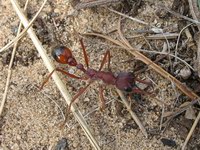
|
Canon A610 7mm (35mm) f/4 1/60 sec ISO Auto P Mode 
|
"Red Bullant" (Portland, 2006) My first insect shot!The clarity and detail really blew my mind. After this I was hooked. BTW, these ants will give you a nasty nip. Check those mandibles. Envenomed too! |

|
Canon A610 7mm (35mm) f/4 1/800 sec ISO Auto P Mode 
|
"Aphids on my Beans" (Portland, 2006) Damn little sap suckers infested my broad beans of all things! Encouraged by the damn ants. (This after they ruined my peach crop). I sprayed them with Mavrik, that fixed 'em!When you see these little aphids with the naked eye they just look like little black blobs. I had no idea they had such well defined legs and even wings. Supposedly the orange ones are incubating a tiny parasitic wasp which will kill them, multiply and reduce the aphid numbers. I saw no such reduction. Let nature control itself? Huh! |
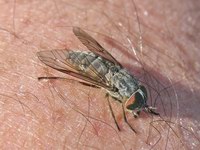
|
Canon A610 7mm (35mm) f/4 1/1000 sec ISO Auto P Mode 
|
"The March Fly's Bite" (Portland, 2006) Normally flies don't let you get close enough to take a macro shot, but March Flies are different. They can't quickly fly away once they've got their proboscis into you, which gives you the chance to swat them, or in this case, take a picture of them! |
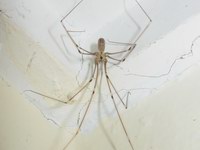
|
Canon A610 7mm (35mm) f/5 1/60 sec ISO Auto A Mode Flash -1eV 2 sec delay 
|
"Daddy Longlegs" (Portland, 2006) I don't know about you but I had never seen a close up of a daddy longlegs before. They are so common you tend not to think about them. This one was perched in the vertex of the entrance hallway walls and ceiling.I was able to frame the shot easily but using natural light I just couldn't get a sharp image. I tried different ISOs and apertures. Then I tried the flash. It worked, but too bright, so I throttled it back and BINGO! |
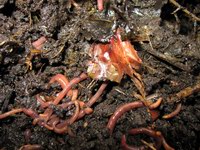
|
Canon A610 7mm (35mm) f/2.8 1/60 sec ISO Auto P Mode Flash -1eV 
|
"Worms in the Compost" (Portland, 2006) I saw this shot when I was turning over the compost one day so I grabbed the camera and set about getting it. It wasn't so easy however as the little annelids kept slipping away. Furthermore, I needed flash, but not too much. |
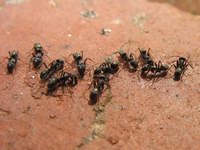
|
Canon A610 7mm (35mm) f/6.3 1/400 sec ISO Auto A Mode Flash -1eV 
|
"Little Ants" (Portland, 2006) If beetles are an easy subject for macro photography, then ants are hard. They are always in motion. Especially the little black ants that you see around the home. They are so small that I had no idea what they really looked like. So this shot was a real eye opener for me.They are small and fast moving and thus difficult to get a focus lock on, but put down some Antrid and they stop to drink it! He he he he. |
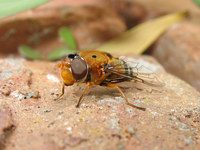
|
Canon A610 7mm (35mm) f/4 1/400 sec ISO Auto P Mode 
|
"Orange Blow Fly" (Portland, 2007) I saw this photogenic fly one afternoon and ran for the camera hoping it would still be there when I returned. I think it must have been lost and exhausted as I haven't seen one since and it was happy to pose for me indefinitely.I was able to get quite close and took multiple shots. I liked the result so much I did a painting of it! |
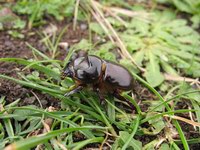
|
Canon A610 7mm (35mm) f/4 1/80 sec ISO Auto P Mode 
|
"Beetle" (Portland, 2007) One of the troubles with invertebrate macro photography is that a small motion on the part of the subject will cause a blur. Beetles are very slow moving, so when I saw this one on the grass I knew I could take my time. Effortless. And check out the IQ. This really shows off the A610 at its best! |
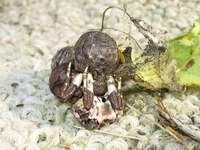
|
Canon A610 7mm (35mm) f/4 1/500 sec ISO Auto P Mode 2 sec delay 
|
"Bird Dropping Spider" (Portland, 2007) This relatively rare spider camouflages itself by resembling a large pile of bird droppings. It sits underneath its eggs which hang from a sort of bag up in a tree. It won't move unless it is sure it's about to be eaten. It took me a week or more to figure out what it was. I knew there was something fishy about the bag of balls but I couldn't see the spider even though I was looking straight at it!After finding out what it was, I pulled the spider and eggs away from the lemon tree with a stick and placed it on some carpet to photograph it. In this shot the spider is underneath the eggs. It didn't move even when I moved it from the tree. Bizarre! BTW It has an AMAZING way of getting food. Check it out. |

|
Canon 400D Tamron 70-300 300mm (480mm) f/11 1/20 sec ISO 400 A Mode 2 sec delay 
|
"Snail on the Path" (Portland, 2008) Saw this snail on the front path one moist morning and thought: "gotta getta shotta that!". I raced inside for my gear, hoping the wee beastie would still be there when I returned ;-)As you can see from the parameters it was quite dull outside and I perforce had to employ a tripod. Fortunately the model was patient while I set up and took various shots. I liked this one, at maximum magnification you can see all the detail in the shell marking and the textured skin of the mollusc. |